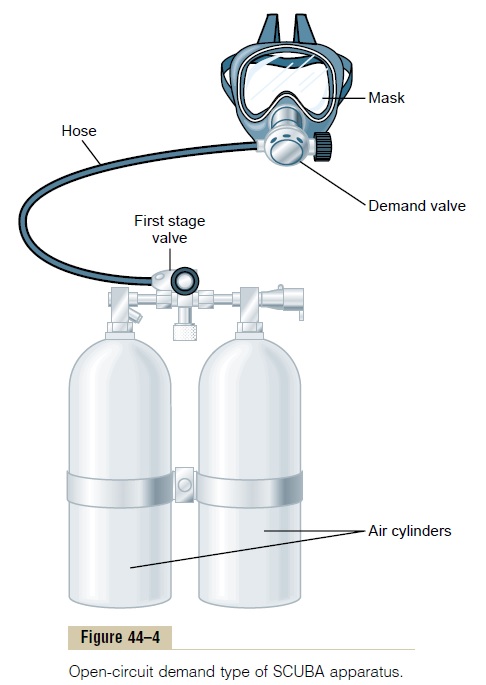Chapter: Medical Physiology: Physiology of Deep-Sea Diving and Other Hyperbaric Conditions
Scuba (Self-Contained Underwater Breathing Apparatus) Diving
Scuba (Self-Contained Underwater Breathing Apparatus) Diving
Before the 1940s, almost all diving was done using a diving helmet connected to a hose through which air was pumped to the diver from the surface. Then, in 1943, Jacques Cousteau popularized a self-containedunderwater breathing apparatus, known as the SCUBAapparatus. The type of SCUBA apparatus used in more than 99 per cent of all sports and commercial diving is the open-circuit demand system shown in Figure 44–4. This system consists of the following com-ponents: (1) one or more tanks of compressed air or some other breathing mixture, (2) a first-stage “reduc-ing” valve for reducing the very high pressure from the tanks to a low pressure level, (3) a combination inhala-tion “demand” valve and exhalation valve that allows air to be pulled into the lungs with slight negative pres-sure of breathing and then to be exhaled into the sea at a pressure level slightly positive to the surrounding water pressure, and (4) a mask and tube system with small “dead space.”
The demand system operates as follows: The first-stage reducing valve reduces the pressure from the tanks so that the air delivered to the mask has a pres-sure only a few mm Hg greater than the surrounding water pressure. The breathing mixture does not flow continually into the mask. Instead, with each

inspiration, slight extra negative pressure in the demand valve of the mask pulls the diaphragm of the valve open, and this automatically releases air from the tank into the mask and lungs. In this way, only the amount of air needed for inhalation enters the mask. Then, on expiration, the air cannot go back into the tank but instead is expired into the sea.
The most important problem in use of the self-contained underwater breathing apparatus is the limited amount of time one can remain beneath the sea surface; for instance, only a few minutes are possi-ble at a 200-foot depth. The reason for this is that tremendous airflow from the tanks is required to wash carbon dioxide out of the lungs—the greater the depth, the greater the airflow in terms ofquantity of air per minute that is required, because the volumes have been compressed to small sizes.
Related Topics